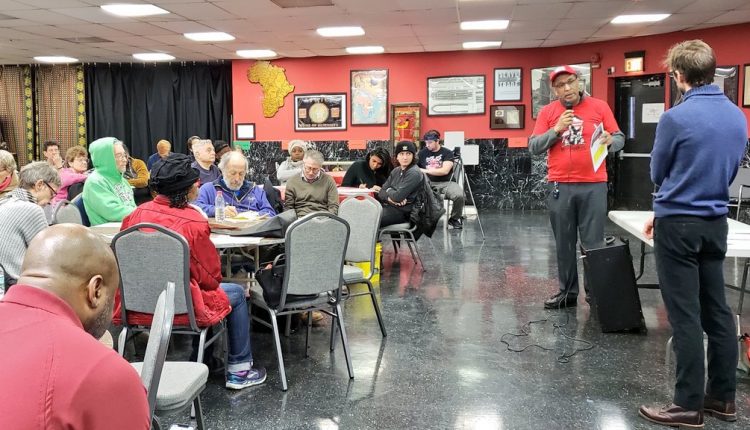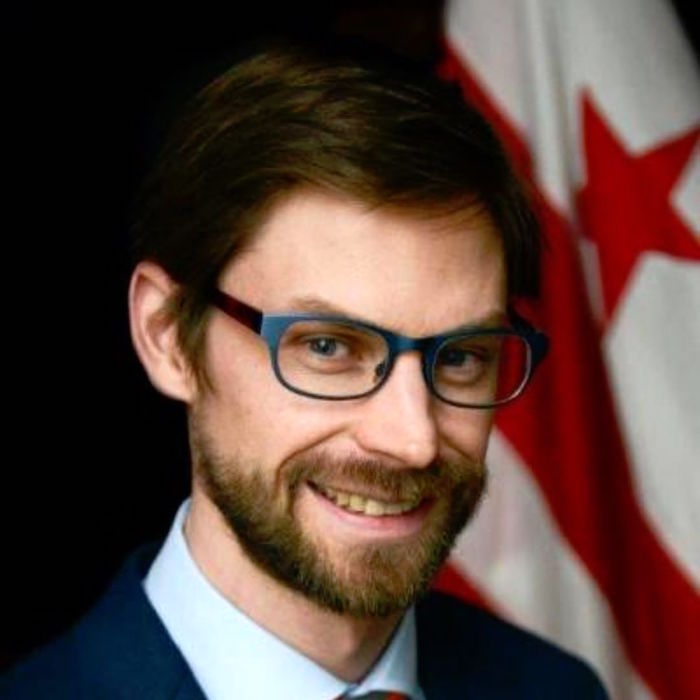
Mayor’s pick for chief planner tells critics of city’s development policies he hopes to earn their trust
The District’s new top planning official on Saturday met some of the biggest critics of the Bowser administration’s land-use policies, promising to listen to activists’ concerns about the pace of development.
Earlier this month, Mayor Muriel Bowser nominated Andrew Trueblood to permanently head the DC Office of Planning after he spent two months as interim director after the departure of Eric Shaw. He’s poised to assume the role as Bowser aims to update the city’s land-use guidelines. The mayor’s proposal, geared in part toward avoiding lengthy legal challenges to large development projects, sparked controversy last year at the DC Council, and lawmakers expect to revisit her plans early this year.
“I don’t expect your trust today, but I hope it can be earned and developed,” Trueblood told a crowd of about 100 residents and neighborhood activists that packed the basement of Union Temple Baptist Church in Anacostia.

Now beginning her second term, Bowser has said she wants to see 36,000 new housing units built in DC by 2025. Many who were in the room Saturday balk at the idea of focusing heavily on market-rate units market-rate units, arguing the city primarily needs more affordable housing for current residents with limited incomes.
Guy Durant, a resident who filed a lawsuit against a development project in Ward 5’s Brookland neighborhood, challenged Trueblood.
“I don’t want you to sell us on what the mayor’s agenda is,” he told Trueblood at the meeting, which was organized by the Grassroots Planning Coalition and Empower DC. “We’re grassroots. We’re from the bottom up. We want you to take what the grassroots want up. Not what the mayor wants down. Are you down with that?”
Trueblood, who was received positively by the audience at several points, said he would listen to advocates, despite ultimately working for the mayor. A few moments later, someone in the crowd called out, “No secret developer meetings!” Durant had said he wanted Trueblood to publicize meetings with private developers.
“I meet with everybody. I meet with advocates,” Trueblood said. “I have to meet with people who are pro-developer. That is part of my job.”
Priorities include small-area plans
Trueblood — who previously served as chief of staff to Brian Kenner, the deputy mayor for planning and economic development — still needs to be confirmed by the DC Council, which has not yet scheduled a hearing on the mayor’s nomination. One of the hot issues for the Office of Planning is revising the Comprehensive Plan. Amending the 1,000-plus-page document is the avenue through which Bowser intends to help developers withstand the kind of appeals that in recent years have stymied several large-scale projects, known in zoning parlance as “planned unit developments” or PUDs.
The administration submitted its first set of amendments last year, running into opposition at a 13-hour DC Council hearing. Critics said the changes diluted the plan and did not explicitly advocate for more affordable housing or against displacement of current residents.
Proponents characterize the changes to the Comprehensive Plan’s Framework Element as a course correction: Activists would no longer be able to halt expansive development projects for being incompatible with the Comprehensive Plan, or would at least have a harder time doing so. In a notable case, the DC Court of Appeals threw out a redevelopment proposal for the McMillan Sand Filtration Site in 2016, and many other projects remain in legal limbo.
While plaintiffs in those cases tend to argue the projects are out of scale with their surroundings and don’t include enough affordable housing, others believe the threat of such appeals has throttled the construction of new units as the city faces a housing shortage.
On Saturday, Trueblood’s words carried some criticism of how the Office of Planning under his predecessor went about seeking the amendments, after having received thousands of comments from residents and developers about changes to the plan.
“I think it was more than what the Office of Planning was expecting, and it bit off a lot,” he said. “Maybe more than could be chewed in the time.”
Trueblood said he will be in talks with the DC Council about intended changes to the mayor’s 60 pages of amendments, which Council Chairman Phil Mendelson says he’ll move to a vote in the coming months once his committee staff drafts a revised version that “puts more emphasis on on housing — and affordable housing — as a priority.” Trueblood expects the Office of Planning to release proposed amendments to other sections of the Comprehensive Plan this fall for public comment.
In addition to working on revisions to the Comprehensive Plan, Trueblood said his priorities include adopting a more systematic approach to housing affordability and preparing small-area plans for neighborhoods and commercial corridors. On the latter, he said the office “once again” must return to planning at the neighborhood level, a task envisioned when the current Comprehensive Plan was adopted in 2006. But citing the cost and time it takes to conduct full small-area studies that ultimately require DC Council review, Trueblood said the office may initially work to “refresh” current plans.
He received applause when he suggested the city should move away from a “places-first” focus on planning — some past plans, he said, seemed to start with the premise that “if you plan, then they will come.” Some activists say the District ought to focus on helping its current residents who need affordable housing rather than pushing for more population growth — and respond with skepticism when District officials and smart-growth advocates say the two goals can be complementary.
“We are as a city right now [at a point] where we need to start with planning for people first and the places they have,” Trueblood said to cheers. “This is a value that I hold.”
In an interview on Monday, Empower DC executive director Parisa Norouzi described Trueblood’s observation as a “good sentiment” that is “very much the opposite” of what she’s heard from Bowser administration officials in the past.
“I hope that he is thinking about that,” she said, but noted: “Again, he works for the mayor.”
Only time will tell how Trueblood’s views shape the administration’s approach and whether he ends up reversing past policies, Narouzi said.
“That will remain a consistent tension, so we’re always happy to have an open dialogue,” she said of Trueblood’s role.
During Q&A as part of his one-hour appearance on Saturday, Trueblood squarely addressed the changing demographics of the city and a desire to avoid displacement.
“We want to make sure that existing residents, longtime residents, low-income residents, residents of color are a part of the future of the city,” he said. “And not only that, but their children and grandchildren are a part of the city.”


Comments are closed.